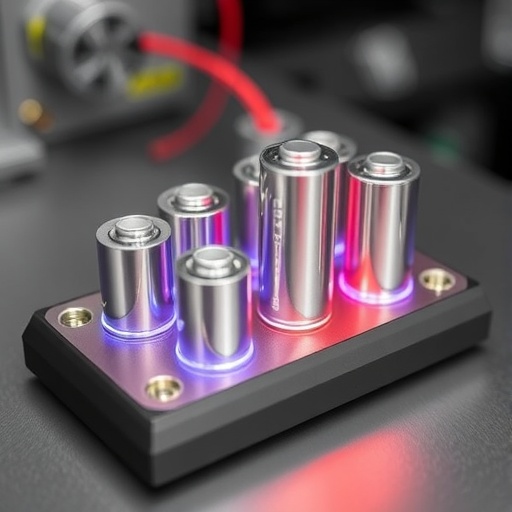In the burgeoning field of energy storage, researchers are constantly exploring the potential for new materials that could revolutionize battery technology. At the forefront of this research is a team led by Ding, B., and colleagues, focusing on a groundbreaking study of cathode composite materials specifically designed for aqueous sodium-ion batteries. This cutting-edge work, titled “Preparation and Electrochemical Performance Study of NMOVC Cathode Composite Materials for Aqueous Sodium-Ion Batteries,” promises to provide significant insights into the capabilities of sodium-ion technology.
The research hinges on the increasingly vital role that sodium-ion batteries are playing as an alternative to the widely used lithium-ion systems. Given that sodium is more abundant and less costly than lithium, the transition to sodium-ion batteries could yield significant economic and environmental benefits. The authors delve into the details of the NMOVC cathode composite materials, elucidating their preparation process and electrochemical performance metrics, which serve as benchmarks for future studies in this promising field.
One of the focal points of the study is the synthesis of NMOVC materials. This involves a meticulous approach to create a composite that balances conductivity, capacity, and stability. The researchers employed various techniques to engineer the composite structure, optimizing the arrangement of constituents to facilitate enhanced ionic and electronic conductivity. This optimization is crucial, as a well-designed composite can significantly impact the efficiency and performance of the nascent sodium-ion batteries.
The electrochemical performance of the NMOVC materials was evaluated through rigorous testing protocols, including charge-discharge cycling and rate capability assessments. These tests were invaluable in determining the longevity and stability of the batteries constructed with the NMOVC cathodes. Data from the study indicated that the NMOVC materials exhibited remarkable cycle stability, outperforming traditional vertical materials like sodium cobalt oxide, thereby marking a vital step toward commercial viability.
Another pivotal component of this study revolves around the reaction mechanisms underpinning the performance of NMOVC cathodes. Understanding these mechanisms allows researchers to fine-tune the composition and processing parameters of the materials to achieve even higher performance levels. Through advanced characterization techniques such as X-ray diffraction and scanning electron microscopy, the team aims to correlate structural properties with electrochemical behaviors, paving the way for future innovations in sodium-ion technology.
In addition, the authors put significant emphasis on the environmental aspects of the NMOVC materials. The synthesis methods utilized are designed to minimize toxic waste and energy consumption, positioning sodium-ion batteries as a more sustainable option within the realm of energy storage. Their commitment to environmental considerations aligns with global initiatives striving for greener technologies, further propelling the urgency and relevance of this research.
The study’s findings can’t be understated—they encapsulate not just a catapulting forward for sodium-ion technology but also a crucial contribution to the battery research community as a whole. By laying a foundation that bridges the gap between theory and practical application, Ding and his team enable subsequent experiments to build upon their significant advancements. This creates a more cohesive landscape in which researchers can thrive and innovate.
The work presented in this article is not merely confined to academic hyperbole; the practical implications of the findings suggest that with continued development, sodium-ion batteries could replace lithium-ion systems in several applications, especially in large-scale energy storage. Factors such as safety, cost, and availability inherently favor sodium-ion technology, making their widespread adoption a distinct possibility.
As the research community responds to the call for energy storage solutions that can meet the growing demands of modern society, studies such as this one will undoubtedly serve as invaluable references. They inspire an entire generation of researchers to further investigate the unexplored potential of sodium-ion batteries. With continued exploration of NMOVC materials, the vision for efficient, sustainable energy storage systems made from abundant resources becomes an attainable reality.
This work also opens the floor for exploring other alternative battery technologies. Just as the transition from lead-acid to lithium-ion was initially mundane, researchers are now funneling their efforts into similar innovations with abundant materials. It emphasizes the dynamic nature of battery research, where even the most overlooked elements can lead to breakthroughs that redefine the landscape.
The study by Ding et al. is a testament to the collaborative spirit in research that transcends geographical boundaries. As partnerships between academia and industry grow stronger, the translation of basic research into commercial applications is becoming an increasingly feasible endeavor. This camaraderie often results in sharing knowledge, resources, and investment to optimize the development of energy storage technologies.
Furthermore, the emphasis on comprehensive analytical techniques in the study signals the trend toward multidisciplinary approaches in battery research. As various scientific disciplines converge, the potential for emergent properties and innovative findings becomes exponential. The research community’s collective efforts ensure that critical barriers are systematically dismantled, offering pathways to practical and efficient energy solutions.
As the world continues to electrify, the implications of this research offer a glimmer of hope and optimism in energy sustainability. The insights gained from NMOVC cathodes are likely to catalyze further advancements in both the understanding of sodium-ion technology and its practical applications. This study represents only a fraction of a burgeoning field destined to evolve rapidly, shaping the future of energy storage systems globally.
In conclusion, the preparations and performance assessments of NMOVC cathode composite materials elevate the profile of sodium-ion batteries. Through the combination of innovative synthesis, rigorous testing, and environmental consciousness, Ding et al. have set the stage for the next generation of battery technology. The pursuit of knowledge in this sphere not only carries profound implications for energy storage but also heralds a new era of sustainable technology.
Subject of Research: Sodium-ion battery technology, NMOVC cathode composite materials
Article Title: Preparation and electrochemical performance study of NMOVC cathode composite materials for aqueous sodium-ion batteries
Article References:
Ding, B., Li, CP., Tang, J. et al. Preparation and electrochemical performance study of NMOVC cathode composite materials for aqueous sodium-ion batteries. Ionics (2025). https://doi.org/10.1007/s11581-025-06590-w
Image Credits: AI Generated
DOI: https://doi.org/10.1007/s11581-025-06590-w
Keywords: sodium-ion batteries, NMOVC materials, energy storage, electrochemical performance, sustainability




